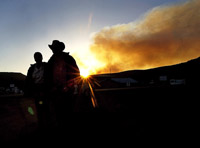| Home | Blog | Ask This | Showcase | Commentary | Comments | About Us | Contributors | Contact Us |

What’s fueling all the fires in Florida and the West?ASK THIS | June 163, 2004When major wildfires break out, the media should be asking forest managers and local officials about more than just the location, size and direction of the flames. They should ask why major fires are occurring more frequently, burning hotter and spreading farther and faster than they used to. What’s gone wrong with our forest management policies? By Norman L. Christensen, Jr. Q: The Bush administration’s Healthy Forests Restoration Act was intended to reduce the risk of wildfires by reducing fuel loads in federal forests. Has it been effective? Q: Why are we having so many major wildfires in recent years? Q: What should the top priority of wildfire management policies be? Although it’s still early in the 2004 wildfire season, major wildfires have already charred tens of thousands of acres in Florida, California, Arizona, New Mexico and Colorado. On the day I write this (June 11) the USDA reports there are eight major wildfires burning out West. National fire managers at the Bureau of Land Management have predicted continued above-normal wildfire activity for the rest of the season in much of the region. Last year was an above-normal year for wildfire activity, too. When major wildfires break out, as they are doing more and more often these days, the media need to look beyond the flames, the human drama (compelling though it may be) and the great photo ops, and ask the question: Why is this fire burning? Not what started it – the answer to that is often lightning, arson or careless accidents – but why was the forest allowed to become so flammable in the first place? The problem is that our current wildfire management policies – including but not limited to the Bush administration’s Healthy Forests Restoration Act – are, at best, misguided. They don’t take into account local conditions like weather and topography, and they fail to give top priority to the most hazardous fuel source in the forest – ground fuels like dry grass, pine needles, dead limbs and low shrubs, which, when ignited, can create enough heat to scorch a tree up to a height of 150 feet. Instead, they focus on trying to "fireproof" our forests by suppressing all naturally occurring wildfires – even small, natural ones that can safely burn off ground fuels while posing no threat to human development or mature trees – and by reducing "excess" fuel loads in fire-prone forests through the selective logging of mature trees. This approach has backfired, and actually made many forests more flammable, not less. Logging leaves behind highly flammable slash debris on the forest floor. And by thinning the tree canopy, loggers decrease moisture levels on the forest floor and create "wind avenues" through the forest that can increase the spread and speed of any wildfire that may start. With drought and urban sprawl exacerbating the wildfire problem in recent years, federal government must reprioritize how and where its wildfire management dollars are spent. We need to focus our resources on wildfire management at the human-forest interface, where suburbs meet the wilderness. And we need to enact wildfire management policies that reduce the accumulation of ground fuels, instead of "reducing fuel loads" by allowing logging companies to thin mature trees, which may be counterproductive, anyway. Reporters need to ask forest managers and local officials about these things when a fire breaks out. It’s not enough just to report that the fire is really big or is threatening some highway or neighborhood. You need to tell your readers or viewers why the wildfire problem is getting worse, and what can be done about it.
|




